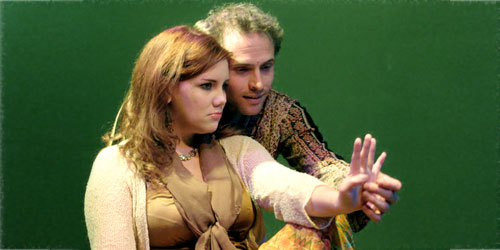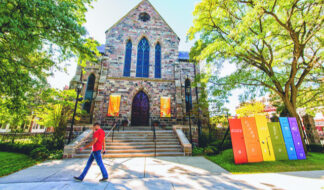
Jamie Weeder and Steven O'Brien in "Women in Love" at the Blackbird Theatre. Photo: Barton Bund
Unlike the characters in the Blackbird Theatre's current production of "Women in Love" who beat around the bush and often don't say what they really mean, I won't keep you wondering what I honestly think about the company's season-opening drama: I love the production, but much of the story doesn't interest me in the least. Listening to overly verbose and unhappy men and women kvetch and talk in circles about love, relationships and social traditions – and take two hours to get to the point – is not how I prefer to spend an evening.
But to leave it at that does this thoughtful, finely staged and extremely well-acted production a terrible disservice.
Personally, I like dramas with meat on their bones. That means I prefer stories that challenge theatergoers to examine their own core beliefs about something, or ponder weighty issues in a way they never considered before. (Recent productions of "Doubt," "Copenhagen," "Proof," "A Picasso" and "Take Me Out" are perfect examples of this.) But more importantly, the protagonist must be someone you can identify with – or at the very least, somehow empathize with or root for.
Frankly, most of the characters in "Women in Love" – adapted by Barton Bund from the novel by D.H. Lawrence – are people I avoid like the plague at cocktail parties and other social gatherings. (Too many platitudes; too little substance. Plus, too much talk; too little action.) But most of the problems I have with the script are, I believe, gender-related; most men simply spend very little time thinking about – let alone talking endlessly about – the topics addressed by Lawrence (and Bund). So I suspect women (and men with far more of a feminine side than I have) may find much more to love about the storyline than I did.
Lawrence's novel, first published in 1920 and set in Britain during the 1910s, is the second to feature sisters Ursula (Jamie Weeder) and Gudrun (Luna Alexander) Brangwen. The two are products of a rigid Victorian society, but each has developed a more modern philosophy regarding marriage and relationships with men. Their theories are put to the test when Ursula meets and eventually marries school inspector Rupert Birkin (Steven Alan O'Brien), while Gudrun has an affair with the heir of a coal mine, Gerald Crich (Jon Ager).
The show's title is a misnomer, however, as the simmering love that drives much of the plot is not between the women or the couples, but the two men. For Rupert, the love of a single woman is not enough; he's also in search of something only another man can provide him. And that man is Gerald.
As you can imagine, the novel's sexual frankness – although tame by today's standards – stunned the sensitivities of polite Edwardian society. Bund, though, doesn't shy away from the book's more controversial material. And more importantly, neither do his actors!
In the production's most startling scene, Rupert and Gerald cement their growing bond with a friendly but very physical wrestling match – in the nude. It's an intense segment, made even more powerful by the intimate nature of the Blackbird's new home. While the SHaut Gallery in Ann Arbor's Kerrytown neighborhood might not work for large productions, the space is well suited for small, emotional projects such as "Women in Love." Why? Because the audience now becomes secret observers of the unfolding action. We're silently with them in their bedrooms and dining rooms and wherever else they travel – which makes us privy to their innermost thoughts and deeds. In fact, we're so close, nothing whatsoever is left to the imagination. Trust me on that!
(This DID present a problem, though, on opening night. Seating is at tables spread out along and partially around the narrow performance space, but I picked the only table that had serious sight line issues. Whenever the action moved to what I didn't realize was stage right, they were out of my view, which made for some interesting moments whenever characters I assumed had left the stage hadn't – and started to speak.)
In fact, Bund – who not only wrote the script and directed the show but also played two minor characters – utilized the limited space quite well throughout the play. Various side rooms and a staircase help for exits and entrances – although, again, I suspect some people may have sight line issues when characters address one another from the staircase. In two quick moments, an actress was standing directly behind and above me – so there was no way to see her without resorting to unusual body contortions. (Those to my far left probably couldn't see a thing.)
Such problems were few and far between, however, and didn't detract much from an otherwise slick performance. (A few script and interpretation problems DID pull me out of the show, however. Were the actors occasionally breaking the fourth wall and talking directly to the audience? Or were we simply other unseen characters in the play? Such breaks were a little unnerving. Also, sound effects at the end of Act I did little to clarify where the action was taking place. I had no idea what we heard were cattle until we were told so. And finally, an important incident with Gerald in the second act was totally unclear!)
So what did I love most about Bund's production? His cast – which always drove my focus back to the story whenever my attention wandered.
In particular, the plot's four main characters are each fully drawn by skilled actors who are thoroughly convincing in their roles. As sisters, Weeder and Alexander share a fondness for one another that's palpable, while O'Brien and Ager dance around their sexual attraction with all the nuances and emotional confusion one would expect of men in their situation. But more importantly, these actors BECOME their characters, and to watch them relate to one another and respond to each other (and even just look into another's eyes) is as real as it gets on stage. (I almost felt like a voyeur!)
Fine support is provided by Eva Rosenwald, Analea Maria Lessenberry and Bund. Bund in particular achieves what many actors attempt but often don't attain: He creates two totally unique characters with nothing more than his voice and mannerisms. (He looked basically the same as both Julius Halliday and artist Loerke.)
The show's technical elements are all satisfactory. Lighting is particularly tricky given the low ceiling and narrow space, but designer Sarah Lucas did much better with it than I expected.
At the end of Thursday night's performance, Bund thanked the audience for coming – and talked briefly about this being a season of challenges. That it is – for thespians and critics alike – not only because of the Blackbird's intimate space, but also the risks the company takes with shows such as this. So while I might not be a fan of this particular play's storyline, I admire the guts and the ambition the Blackbird shows every time they mount a new show. I never know what to expect – and that's just the way like my theater!
REVIEW:
'Women in Love'
Blackbird Theatre, 325 Braun Ct., Ann Arbor. Thursday through Sunday through Oct. 16. Contains nudity. $15-$25. 734-332-3848. http://www.blackbirdtheatre.org










